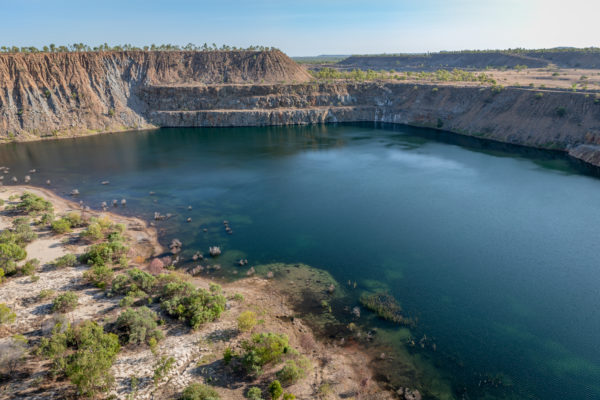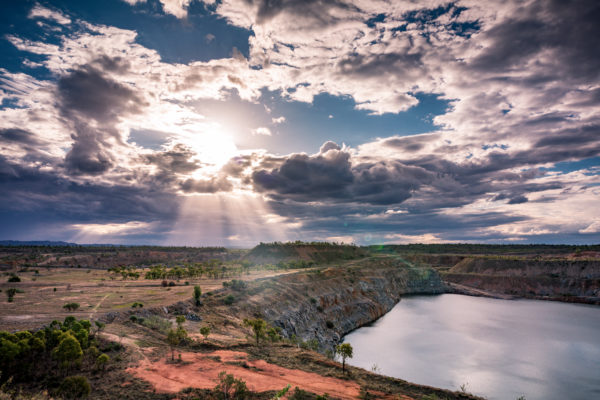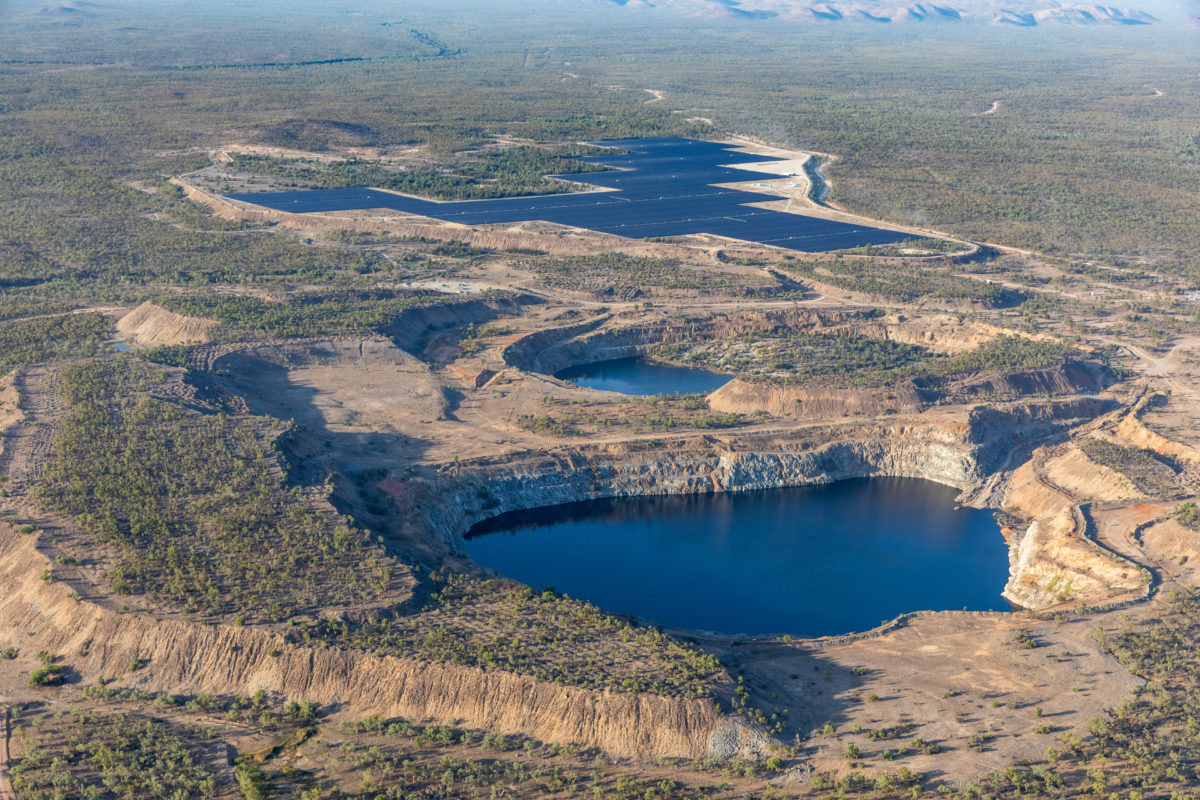Today, Genex Power’s Kidston Clean Energy Hub, which is centred on two massive abandoned gold-mining pits in Far North Queensland, hit pay dirt: the signing of a binding energy storage services agreement (ESSA) under which EnergyAustralia will operate the envisaged 250 MW pumped storage asset for up to 30 years, is the lynchpin for further development of the innovative hub, and will provide critical system stability to the grid in this renewables-rich area of the state.
“The K2-Hydro project will be the first pumped-storage hydro project in the National Electricity Market in almost 40 years,” Genex Power’s CEO James Harding said in the company announcement this morning.
He added, “It will create over 500 jobs during construction,” which is expected to begin after the forecast financial close in the Q3 of 2020; and, he said, it will, “deliver significant economic benefits to Queensland through providing reliable generation for the grid and applying downward pressure on wholesale electricity prices.”
Kidston Clean Energy Hub was granted critical infrastructure status in mid-2017 by Queensland’s Palaszczuk Labor Government, when then state Development Minister, Dr Anthony Lynham, said, the project would also “contribute to our commitments to deliver more renewable energy over the coming years.”
The financial chain of events
The project has since overcome numerous hurdles, including a failed first attempt at joint ownership of the Pumped Storage Hydro Project with Energy Australia, but with the new agreement in place, Genex, which has been operating Kidston’s 50MW Solar Stage 1 project since 2017, and is currently developing the Jemalong Solar Project near Forbes in New South Wales, is optimistic that its 770 MW pipeline of renewable projects will continue to roll out in the near future.
“This contract is critical,” Simon Kidston, Executive Director of Genex Power told pv magazine today, “because our banker, which is the Northern Australia Infrastructure Facility (NAIF), can now see 30 years of locked-in revenue that will enable us to not only provide a return to our shareholders, but also to repay the loan.”
Under the ESSA, EnergyAustralia, which is owned by Hong Kong-based China Light and Power Group (CLP), will have full operational dispatch rights for the hydro plant, in exchange for a fixed annual rental payment that will increase over the term of the agreement.
The 30-year agreement for operation of the asset is divided into 10-year terms, with two options to extend after the first 10-year period; and should EnergyAustralia take the agreement to its full extension, it will have the right to acquire Genex’s holding in the project which has an expected life of at least 80 years.
Too big an Australian bite for China Light and Power
The original proposal was for a full 30-year contract with EnergyAustralia under which the gentailer would own 50% of the pumped-hydro component of the hub, and guarantee revenues for the first 30 years of the joint venture.
“We were very close to finalising the deal in October of last year, but for CLP it was too big an exposure for them to take in one transaction,” says Kidston.
EnergyAustralia’s request to renegotiate could have had a fatal-to-the-project domino effect, jeopardising finance arranged with the Federal Government’s NAIF; putting major investment by Japan’s J-Power, whose commitment was contingent on federal funding, in doubt; and causing Genex to call a halt to trading of its securities.
When NAIF extended its financing opportunity to June 2020, the funding stack reassembled like a film on rewind.
Managing the unpredictable COVID-19 risk
Over the past four months, the Genex has successfully renegotiated its proposal to Energy Australia: “We still get 30 years of partnership but it’s broken down into bite-sized chunks,” more palatable to the holding company CLP, says Kidston.
He says that financial close of K2-Hydro could be achieved earlier than the third quarter of this year, but that the unpredictability of the Coronavirus outbreak and its progression had led the company to be conservative in its projections.
“I think COVID-19 is a manageable risk for us,” says Kidston. “The biggest milestone is the announcement today — that’s the catalyst to unlock this project.”

Photo: Genex Power
Earthworks, tunnelling and turbines
With finances in place, construction will begin: first the upper Wises Pit reservoir will be enlarged; then water currently in the lower Eldridge Pit will be pumped into the upper reservoir to allow tunnelling, caverning, and installation of turbines before linking the two pits.
Completion of the three-year project, at a capital cost of $700 million, will then enable expansion, by up to 270 MW, of Kidston Solar; and potential development of the 150 MW Kidston Wind Project, which is currently undergoing feasibility studies and showing a strong consistent wind resource.
“Up in North Queensland, you’ve got a lot of solar,” says Kidston. “Some would say a little bit too much solar…”
Stabilising the solar-jostled north
This month, the Australian Energy Market Operator had warned that two solar farms (the 125 MW Sun Metals project; and Pacific Hydro Australia’s 100 MW Haughton Solar Farm) and RATCH-Australia’s Mt Emerald wind farm could have their generation slashed to zero under certain conditions.
Their ability to generate at full capacity in an area light on transmission but booming with renewable generation is dependent on the operation of Barron Gorge and Kareeya hydro plants and Gladstone, Stanwell and Callide Coal-fired power stations. If one or more hydro plant units are offline, for example, the three renewable plants could be limited to 70% or 80% of generation capacity.
Kidston’s K2-Hydro, says its namesake executive director, will provide more stabilising synchronous generation to the load-challenged north, with new transmission connecting it to other resources in the area: “When we pump, we’ll consume energy from the grid, whether that’s energy sourced from next door or from 1,000 kilometres away. The electrons will flow to the nearest point from generation to consumption,” he says.
“The introduction of K-2 Hydro will benefit not just Queensland consumers, but also the industry, enabling more renewables to be developed.”

Photo: Genex Power
Long live ARENA!
Kidston says that support from the Australian Renewable Energy Agency (ARENA) and Clean Energy Finance Corporation (CEFC) has been “critical” to initiating and advancing Genex’s vision for its Clean Energy Hub:
- ARENA has provided development funding for the pumped-hydro project since 2015; “they’ve helped us fund all the studies, all the technical works and now some of the legal costs associated with the project development,” says Kidston. Of $30 million needed to bring the project to this stage, ARENA has provided $9 million.
- CEFC was one of two original financiers on the Kidston 1 Solar Farm, which has since been refinanced; and the CEFC is now providing debt funding for the Jemalong Solar Project, which is scheduled to be completed at the end of this year.
The Palaszczuk government has also allocated up to $132 million for construction of the 186 km transmission line from Kidston to Mount Fox near Ingham, which will be owned and operated by state-owned transmission operator Powerlink.
The ducks on these big pumped-hydro ponds are all in a row to help Queensland manage its renewable bonanza and make the most of lowest-cost, renewable energy generation.
“At times in Queensland you’ve got surplus solar energy in the daytime,” says Kidston, “which doesn’t correlate with peak demand; K2-Hydro enables energy shifting — we can soak up excess energy during the day and generate that power into the evening peaks.” It’s great to see this project emerge from its financial trough.
This content is protected by copyright and may not be reused. If you want to cooperate with us and would like to reuse some of our content, please contact: editors@pv-magazine.com.









What great news and 500 Queensland jobs during construction.
Future generations will be grateful for projects like this when they are so harmed by coal expansion.